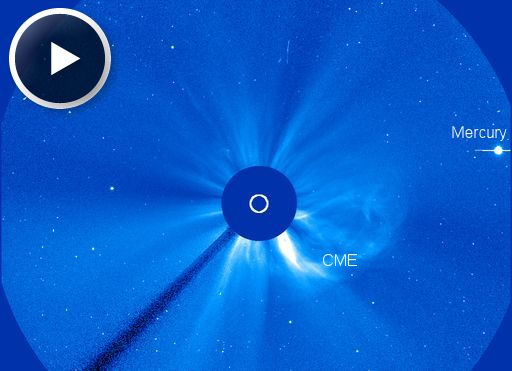SOLAR WIND: Earth is inside a fast-moving stream of solar wind that is putting pressure on our planet's magnetosphere. A gust or shift in the wind's magnetic polarity could spark a geomagnetic storm. NOAA forecasters estimate a 25% chance that this could happen on August 18th. High-latitude sky watchers should be alert for auroras. Aurora alerts: text, voice.
INCOMING CME: A CME might be heading for Earth. It was propelled into space by a double-blast of M-class solar flares (M3 and M1) on August 17th around 1830 UT. SOHO (the Solar and Heliospheric Observatory) caught the CME emerging from the blast site, sunspot AR1818:
The expanding cloud is not squarely Earth-directed. If it hits our planet's magnetic field, the blow will probably be a glancing one. Estimated time of arrival: August 19th or 20th. Stay tuned for a more precise forecast later today. Solar flare alerts: text, voice.

Solar wind
speed: 550.6 km/sec
density: 0.5 protons/cm3
explanation | more data
Updated: Today at 1517 UT
X-ray Solar Flares
6-hr max: C1 1131 UT Aug18
24-hr: C1 1131 UT Aug18
explanation | more data
Updated: Today at: 1500 UT
![]()
Daily Sun: 18 Aug 13
Sunspot AR1818 has a 'beta-gamma-delta' magnetic field that harbors energy for strong flares. Credit: SDO/HMI
![]()
Sunspot number: 96
What is the sunspot number?
Updated 18 Aug 2013
Spotless Days
Current Stretch: 0 days
2013 total: 0 days (0%)
2012 total: 0 days (0%)
2011 total: 2 days (<1%)
2010 total: 51 days (14%)
2009 total: 260 days (71%)
Since 2004: 821 days
Typical Solar Min: 486 days
Update 18 Aug 2013
The Radio Sun
10.7 cm flux: 125 sfu
explanation | more data
Updated 18 Aug 2013
![]()
Current Auroral Oval:
Switch to: Europe, USA, New Zealand, Antarctica
Credit: NOAA/POES
![]()
Planetary K-index
Now: Kp= 2 quiet
24-hr max: Kp= 2 quiet
explanation | more data
Interplanetary Mag. Field
Btotal: 2.7 nT
Bz: 2.0 nT north
explanation | more data
Updated: Today at 1517 UT
![]()
Coronal Holes: 18 Aug 13
Earth is inside a stream of solar wind flowing from this coronal hole. Credit: SDO/AIA.





